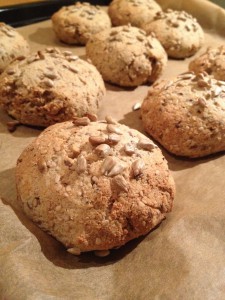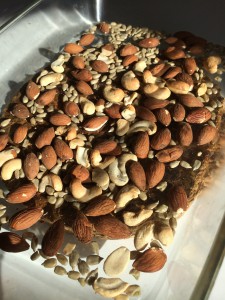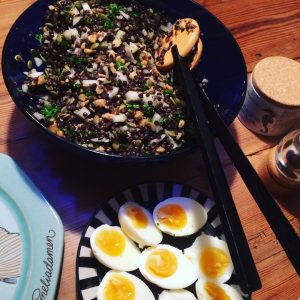 Med jämna mellanrum dyker det upp tidningsrubriker som säger att man absolut inte ska ta bort gluten och spannmål utan att konsultera läkare. Men det är få kontrollerade studie som undersökt detta. Mycket är bara lösa påståenden. Här kommer dock en ny kvalitetsstudie i form av en randomiserad, kontrollerad studie som jämför en låg-gluten-kost med en hög-gluten-kost. Studien visar att mindre gluten leder till mindre “ballongmage” (typiskt symtom på IBS/SIBO) och mindre vätgas i utandningsluft (även det en indikation på SIBO), mer mättnadshormon och mer viktnedgång trots likvärdigt energiintag.
Med jämna mellanrum dyker det upp tidningsrubriker som säger att man absolut inte ska ta bort gluten och spannmål utan att konsultera läkare. Men det är få kontrollerade studie som undersökt detta. Mycket är bara lösa påståenden. Här kommer dock en ny kvalitetsstudie i form av en randomiserad, kontrollerad studie som jämför en låg-gluten-kost med en hög-gluten-kost. Studien visar att mindre gluten leder till mindre “ballongmage” (typiskt symtom på IBS/SIBO) och mindre vätgas i utandningsluft (även det en indikation på SIBO), mer mättnadshormon och mer viktnedgång trots likvärdigt energiintag.
Forskarna skriver bl.a. att:
“Gluten is a major dietary component in wheat, rye and barley, and consists of proteins that are partially resistant to proteolytic digestion due to a high content of proline and glutamine1,2. Large gluten peptides including gliadin escape gastric digestion and accumulate in the small intestine, where they may interact with the immune system3,4, affect the intestinal permeability5,6,7, and modify the gut microbial activity8,9. However, beyond the reduction in gluten, a low-gluten dietary regime also entails a replacement of dietary fibres of gluten-rich cereals such as wheat, rye and barley with dietary fibres from other sources.”
“We find that a low-gluten diet, in comparison with a high-gluten diet, induces changes in the composition and function of the gut microbiome”
“participants reported improved postprandial well-being after the standardised meal following the low-gluten diet compared to the high-gluten diet”
“We did not find any differences in measures of glucose and lipid metabolism (Supplementary Table 7). However, we found a decrease in body weight, on average 0.8 ± 0.3 kg, following the low-gluten dieting for 8-week compared with the high-gluten diet period”
“We also demonstrated an increase in postprandial plasma concentrations of peptide YY (PYY) in response to the standardised meal after the low-gluten intervention[…]PYY is a gut hormone released into the circulation in a nutrient-dependent manner and is known to reduce appetite23. However, we did not observe any differences in total energy intake during the two interventions”
Forskarna konkluderar att effekter av en lågglutendiet hos vuxna utan celiaki kan bero på kvalitativa förändringar i kostfiberintag.
“Adherence to a low-gluten diet has become increasingly common in parts of the general population. However, the effects of reducing gluten-rich food items including wheat, barley and rye cereals in healthy adults are unclear. Here, we undertook a randomised, controlled, cross-over trial involving 60 middle-aged Danish adults without known disorders with two 8-week interventions comparing a low-gluten diet (2 g gluten per day) and a high-gluten diet (18 g gluten per day), separated by a washout period of at least six weeks with habitual diet (12 g gluten per day). We find that, in comparison with a high-gluten diet, a low-gluten diet induces moderate changes in the intestinal microbiome, reduces fasting and postprandial hydrogen exhalation, and leads to improvements in self-reported bloating. These observations suggest that most of the effects of a low-gluten diet in non-coeliac adults may be driven by qualitative changes in dietary fibres.”
Man ser en minskning i mängden bakterier på en lågglutenkost i den här studien, inklusive typiska “goda” bakterier, vilket man alltså hänför till förändringar i fiberintag. Det verkar alltså viktigt att ersätta spannmål med annan fiberinnehållande mat, såsom mer grönsaker för att bibehålla den goda tarmfloran i tjocktarmen.

 En av våra mest allvarliga allergier är jordnötsallergi. Jordnötsallergi är relativt vanligt och kan i värsta fall leda till en livshotande allergisk reaktion. Idag anser man att den som är allergisk mot jordnötter måste undvika jordnötter resten av livet.
En av våra mest allvarliga allergier är jordnötsallergi. Jordnötsallergi är relativt vanligt och kan i värsta fall leda till en livshotande allergisk reaktion. Idag anser man att den som är allergisk mot jordnötter måste undvika jordnötter resten av livet. Trots larmrapporter och negativ publicitet dyker allt fler produkter med sötningsmedel upp på marknaden. Har rädslan för socker vuxit sig starkare än den för de omskrivna tillsatserna?
Trots larmrapporter och negativ publicitet dyker allt fler produkter med sötningsmedel upp på marknaden. Har rädslan för socker vuxit sig starkare än den för de omskrivna tillsatserna? Hur jag räddade mina barn från socker, skriver en läkare som rubrik på sin artikel. “The overconsumption of sugar has became a normal part of our culture. A recipe for fighting back” Överkonsumtionen av socker har blivit normalt. Här kommer ett recept på hur du kämpar emot.
Hur jag räddade mina barn från socker, skriver en läkare som rubrik på sin artikel. “The overconsumption of sugar has became a normal part of our culture. A recipe for fighting back” Överkonsumtionen av socker har blivit normalt. Här kommer ett recept på hur du kämpar emot. Bra där! SVT vetenskap har ett litet videoklipp med Emma Frans om hur du ska tänka kring nya rön, forskning och medielarm.
Bra där! SVT vetenskap har ett litet videoklipp med Emma Frans om hur du ska tänka kring nya rön, forskning och medielarm. Enligt en stor fransk studie löper de som äter mest ekologisk mat 25 procent lägre risk att drabbas av cancer jämfört med dem som främst äter “konventionellt” odlade livsmedel. Studien följde 70 000 personer under fyra och ett halvt år. Den visade att de som år mest ekologisk mat löpte mindre risk att utveckla cancer jämfört med dem som åt minst. Forskarna som genomförde studien bedömer att vi genom att välja i huvudsak ekologiska livsmedel avsevärt minskar risken att drabbas av cancer.
Enligt en stor fransk studie löper de som äter mest ekologisk mat 25 procent lägre risk att drabbas av cancer jämfört med dem som främst äter “konventionellt” odlade livsmedel. Studien följde 70 000 personer under fyra och ett halvt år. Den visade att de som år mest ekologisk mat löpte mindre risk att utveckla cancer jämfört med dem som åt minst. Forskarna som genomförde studien bedömer att vi genom att välja i huvudsak ekologiska livsmedel avsevärt minskar risken att drabbas av cancer. Nu kommer nya råd från Livsmedelsverket om skolmaten: mer grönt på menyn och inga sötsaker i skolcaféet!
Nu kommer nya råd från Livsmedelsverket om skolmaten: mer grönt på menyn och inga sötsaker i skolcaféet! 5:2 var det som fungerade bäst enligt SVT:s experiment ”Bästa dieten”. De två som åt enligt 5:2 förbättrade sin hälsa och forskarna tolkar därför förändringen som ett resultat av 5:2-fasta. Men även de andra medverkande överraskades av hur mycket de påverkades av kostomställningen.
5:2 var det som fungerade bäst enligt SVT:s experiment ”Bästa dieten”. De två som åt enligt 5:2 förbättrade sin hälsa och forskarna tolkar därför förändringen som ett resultat av 5:2-fasta. Men även de andra medverkande överraskades av hur mycket de påverkades av kostomställningen. Många efterfrågar en lite mer nyanserad bild av hur man bäst äter för miljön och klimatet, än det vanliga “ät mindre kött och mer vegetariskt”.
Många efterfrågar en lite mer nyanserad bild av hur man bäst äter för miljön och klimatet, än det vanliga “ät mindre kött och mer vegetariskt”.
Senaste kommentarer